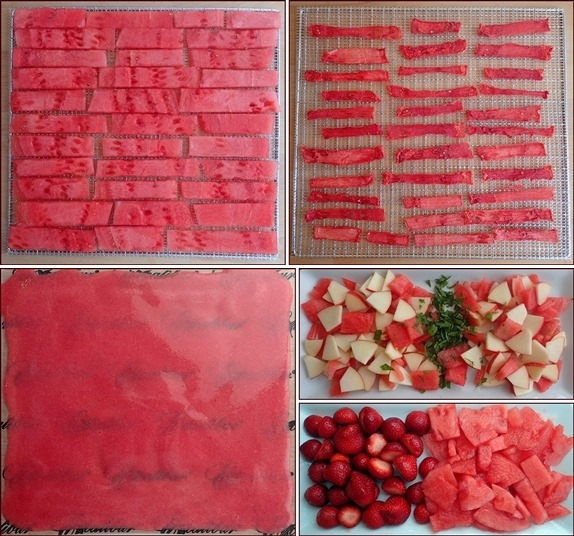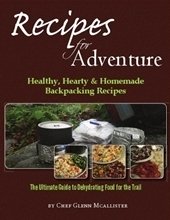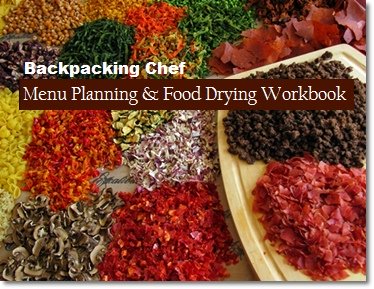Dehydrating Watermelon & Watermelon Fruit Leather
What is the benefit of dehydrating watermelon?
Imagine carrying a 20 pound watermelon in your backpack. Ok, how about if the watermelon only weighed a pound after drying it? Or maybe you’d be happy with the equivalent of a couple of slices for less than an ounce.
At 92% water, you get a huge weight savings and a wonderful concentration of sweetness—almost like candy—when you dehydrate watermelon.
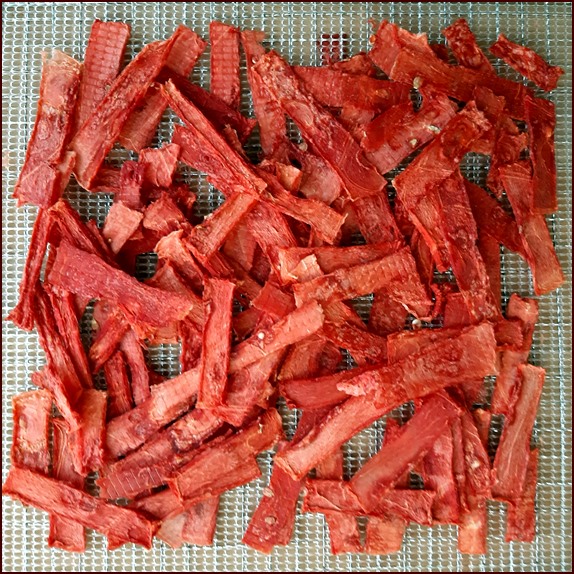
Photo: Dehydrated watermelon for a hiking party of 4.
This article shows how to dehydrate watermelon and watermelon fruit leather. I cut as much of the watermelon as possible into “watermelon jerky” strips, and set aside the smaller pieces to make watermelon fruit leather.
With its high water content, watermelon needs to be combined with drier fruits to make the best fruit leather, or it can be cooked down on the stove. I’ll show you how to do it both ways, and how to rehydrate it into healthy backpacker puddings, like Watermelon-Cherry-Chocolate Pudding and Strawberry-Watermelon Pudding.
Table of Contents
Cutting Watermelon for Dehydration
Packing & Storing Dehydrated Watermelon
How to Dehydrate Watermelon Fruit Leather
Cooked Watermelon Fruit Leather
Choosing a Good Watermelon for Dehydrating
Purchase a seedless watermelon to save the time of picking the seeds out.
The watermelon should be free from bruises and gashes.
The spot where the watermelon rested on the ground should be a creamy yellow color indicating it had plenty of time to ripen and get sweet in the sun.
Watermelon Nutritional Benefits
A 2-cup serving of watermelon (280 grams) has 80 calories and contains healthy amounts of vitamin A, B1, B6, and C; plus potassium, magnesium, and phosphorus.
Source: Watermelon.org
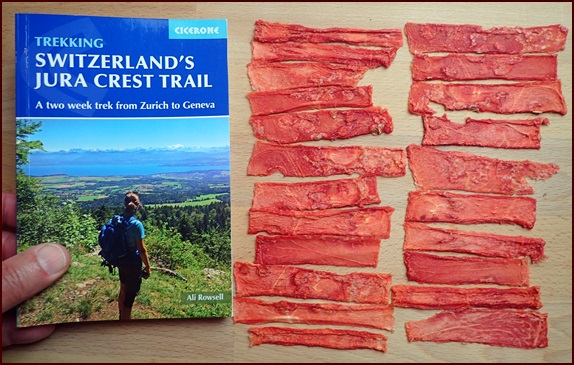
Photo: A 280 gram (10 oz.) serving of fresh watermelon, shown after dehydrating. Weight is only 22 grams (less than 1 ounce).
Cutting Watermelon for Dehydration
Before cutting the watermelon, wash and dry it to remove any contaminants.
Cut the watermelon in half longwise.
Place the watermelon halves cut-side down and cut slices 1-inch thick (2.5 cm).
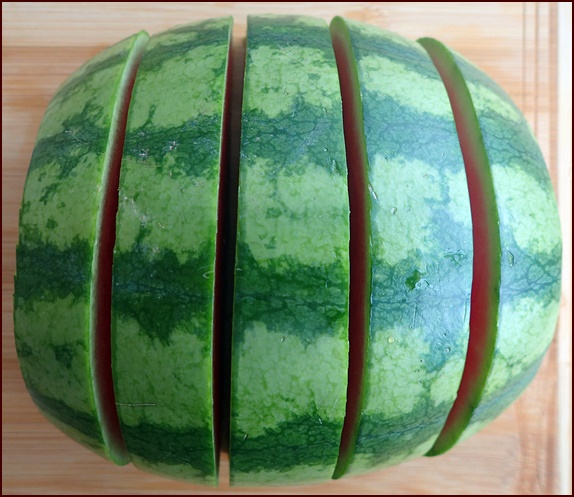
Photo: Half of a small watermelon cut into 1-inch slices.
Cut away the rinds, then cut watermelon slices into ¼-inch thick strips (.5 cm)
Lengths will vary, but shoot for 3-inch long strips (8 cm).
Dehydrating Watermelon
Place watermelon strips directly on mesh dehydrator sheets.
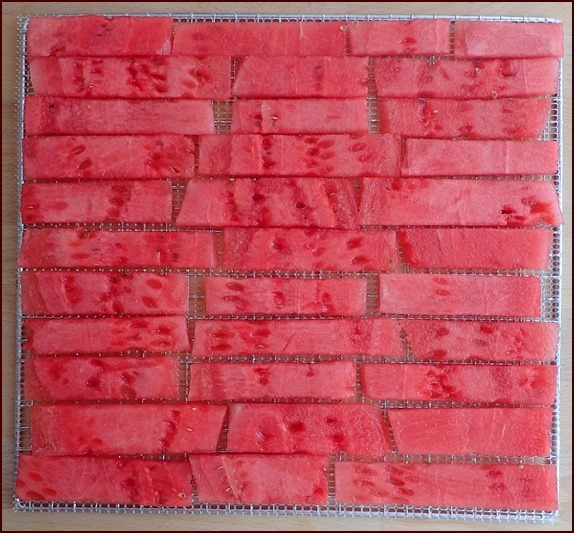
The watermelon in the photo had some seeds, which I mostly picked out, except for some of the immature white seeds.
Dehydrate watermelon at 135°F (57°C) for approximately 11–12 hours. Time can be longer using some dehydrators or when you are dehydrating watermelon on many trays. It will take longer to dry watermelon if you use solid silicone drying trays or sheets, which block air from rising through the watermelon from below.
Dehydrated watermelon with be pliable and slightly tacky due to the high concentration of natural sugar.
Yield: One dehydrator tray of watermelon (500 g) will weigh approximately 40 grams when dry.
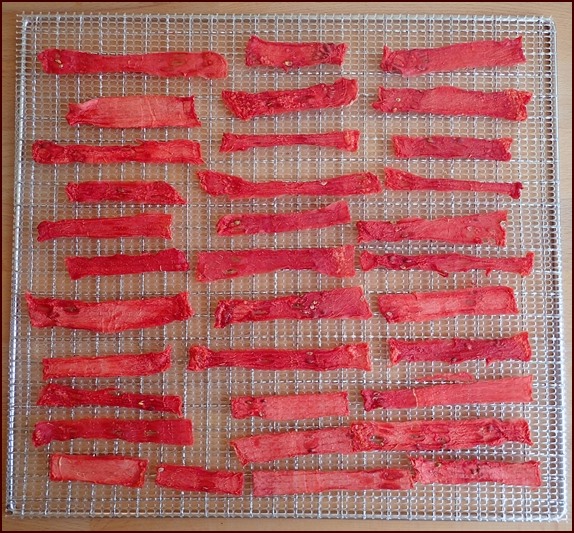
Photo: Dehydrated watermelon “jerky” on a mesh drying sheet over a stainless steel wire tray. It is harder to remove dried watermelon from wire trays if you don’t use flexible mesh drying sheets on top of them.
Seasoning Ideas for Dehydrating Watermelon
I like my dehydrated watermelon plain, but Backpacking Chef readers shared a few ways they like to spice it up:
Sprinkle any of these seasonings, in moderation, on top of the watermelon before drying it:
- Tajin Seasoning
- Strawberry Jell-O powder
- Shredded Coconut
- Malic Acid
- Pinch of Salt
Go easy with the seasoning the first time you try them. You don't want to overpower the sweet, natural taste of the watermelon.
Packing & Storing Dehydrated Watermelon
Dehydrated watermelon will absorb moisture from the air quickly. As soon as it is cool, store it in an air/water tight container.
Wrapping dried watermelon strips in parchment paper or wax paper will keep it from sticking to itself. It’s much easier to eat it that way on the trail.
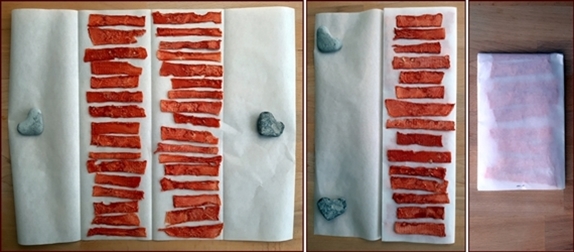
Fold Dehydrated Watermelon in Parchment Paper
Make equal folds in parchment paper so that you have four columns.
Place dried watermelon strips on the two center columns.
Fold the empty column on the left over the occupied column to its right. Then fold that over the next column.
Place more watermelon strips on the last open column, then fold the previously wrapped watermelon over that.
Lastly, fold the package in half and slide it into a Ziploc bag. Several will fit in a single Ziploc bag. If desired, you can staple layers of the paper to create compartments, but it’s not really necessary if you take care when opening.
For long term storage, you can just place several of the wrapped watermelon packages in a vacuum seal bag without Ziploc bags, and seal.
How to Make Watermelon Fruit Leather
If what you want is 100% watermelon goodness, then it’s better to just dry slices of watermelon than to make watermelon fruit leather out of it. But when combined with other fruits, watermelon makes delicious fruit leather.
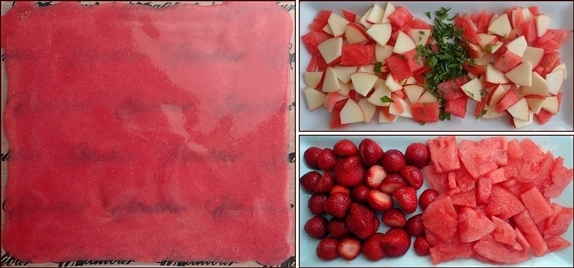
The challenge with dehydrating watermelon fruit leather is its 92% water content. When you place watermelon in a blender, you get loose water which will run off the dehydrator tray.
Many websites, like this one, suggest straining off the water after blending the watermelon and replacing the natural sugars that were in the liquid with refined sugar. That method does work, but isn’t it healthier to hang on to the natural sugars, flavors, and nutrients in the watermelon juice?
To retain those healthy juices in your homemade watermelon fruit leather, a better option is to combine the watermelon with a fruit containing less water. That will result in a smoothie consistency that will make a nutritious fruit leather.
Bananas, at 74% water, are the driest and most effective fruit to blend with watermelon to achieve a smoothie consistency.
Other fruits on the drier end of the scale are: grapes or cherries at 81% water, and pears or apples at 84% water.
In the watermelon fruit leather recipe below, I wanted to combine the flavor of strawberry and watermelon, but both of those have 92% water. Bananas to the rescue!
Strawberry-Banana-Watermelon Fruit Leather

Servings: Makes 3 Fruit Leathers
Ingredients:
- 2 cups watermelon (300 g)
- 2 cups strawberries (250 g)
- 1 cup bananas (125 g)
Procedure:
Wash and dry strawberries before cutting into pieces. Blend all fruit to a smoothie consistency.
This recipe will produce approximately 3 cups of blended fruit. Spread 1 cup on each of 3 trays covered with nonstick sheets.
Dehydrate at 135°F (57°C) for 8–10 hours. Dried fruit leather will be pliable. Fruit leathers with banana as an ingredient usually dry faster than fruit leathers without bananas.
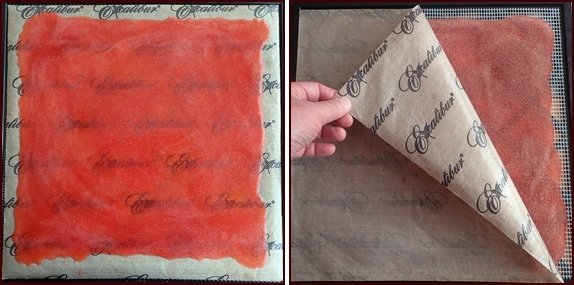
Photos above show blended fruit spread thinly on a nonstick sheet. When the fruit leather is substantially dried, flip it over and peel off the nonstick sheet. Finish drying leather directly on mesh dehydrator sheet. This method reduces drying time.
Apple-Mint-Watermelon Fruit Leather
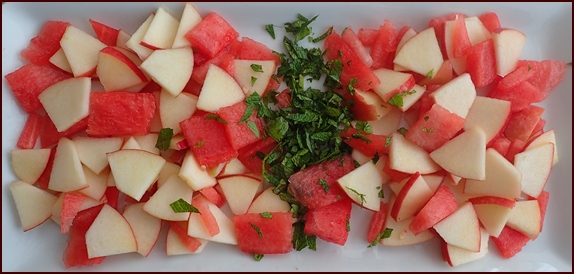
Servings: Makes 3 Fruit Leathers
Ingredients:
- 1⅔ cups watermelon (250 g)
- 3½ cups apple (425 g)
- 2 Tbsp. chopped fresh mint
- 1 tsp. honey (optional)
Procedure:
Wash apples, remove cores, and cut into pieces. Leaving the skin on is more nutritious.
Run all ingredients through a blender until smooth. Add more apple if the mix needs thickening.
This recipe will produce approximately 3 cups of blended fruit. Spread 1 cup on each of 3 trays covered with nonstick sheets.
Dehydrate at 135°F (57°C) for 11–12 hours. Dried fruit leather will be pliable.
Cherry-Apple-Mint-Watermelon Fruit Leather
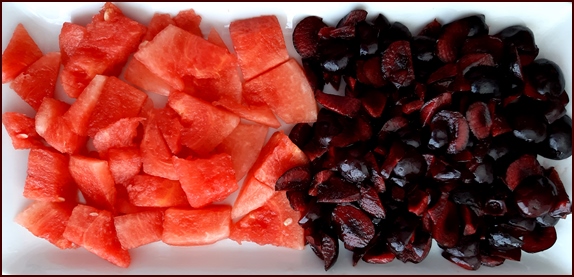
Photo: The original plan was to make watermelon fruit leather with just cherries and watermelon, but it was still a little watery after blending. A small amount of apple made it thicker. Pear works well, too.
Servings: Makes 3 Fruit Leathers
Ingredients:
- 1⅔ cups watermelon (250 g)
- 40 cherries (250 g)
- 1 apple or pear (125 g)
- 2 Tbsp. chopped fresh mint
- 1 Tbsp. fresh lime juice
- 1 tsp. honey (optional)
Procedure:
Wash apple or pear, remove core, and cut into pieces. Leaving the skin on is more nutritious.
Wash and dry cherries, and cut fruit off pits. A cherry pit remover can save time.
Run all ingredients through a blender until smooth. Add more apple or pear if the mix needs thickening.
This recipe will produce approximately 3 cups of blended fruit. Spread 1 cup on each of 3 trays covered with nonstick sheets.
Dehydrate at 135°F (57°C) for 10–11 hours. Dried fruit leather will be pliable.
Cooked Watermelon Fruit Leather
Simmering watermelon on the stove with a complimentary fruit is another way to reduce the water content before turning it into fruit leather. As mentioned previously in this article, if you want 100% watermelon flavor, your best bet is to simply dehydrate strips of watermelon.
To end up with approximately 1 cup of cooked fruit after blending, start with 250 grams of watermelon and 250 grams of another fruit, like strawberries (shown below). Triple these quantities to produce 3 fruit leathers.
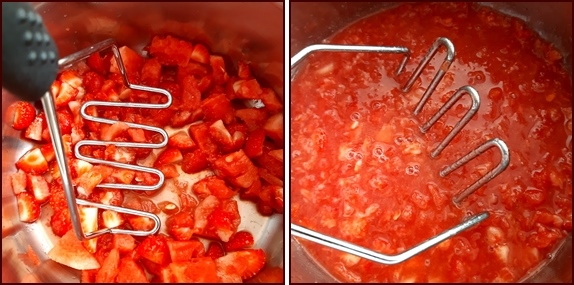
Place fruit pieces in a pot and mash them with a potato masher to liberate some juices. Simmer at a light bubble for approximately 45 minutes while occasionally mashing some more.
Once the mixture appears thick enough, run it through a blender.
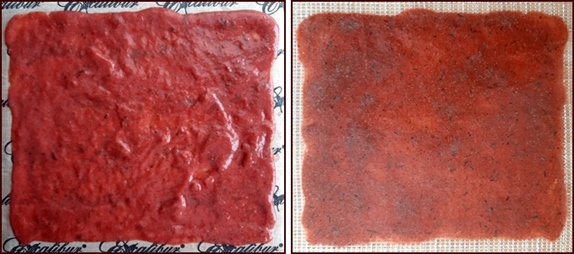
Spread 1 cup of blended fruit on each dehydrator tray using a nonstick sheet.
Dehydrate at 135°F (57°C) for 10–12 hours. Cooked fruit leather mix may take a little longer to dry than fresh blended fruit.
Packing Watermelon Fruit Leather

Fruit leather made with watermelon may be stickier than other fruit leathers. To keep it from sticking to itself, fold it up in parchment paper or wax paper. The creases caused by folding make it easy to tear off pieces to enjoy while you hike. Several folded fruit leathers will fit nicely in a Ziploc bag.
Pack dehydrated watermelon and fruit leathers in air/moisture proof containers for long term storage up to a year. For short term storage, a Ziploc bag is sufficient to block moisture from infiltrating the leather. Wrapped fruit leather may be stored in the refrigerator using a Tupperware-type container. It’s very enjoyable when eaten cold.
Watermelon Fruit Leather Pudding Recipes
While delicious as a hiking snack while you’re moving, the watermelon fruit leathers featured in this article can also be rehydrated quickly in cold water.
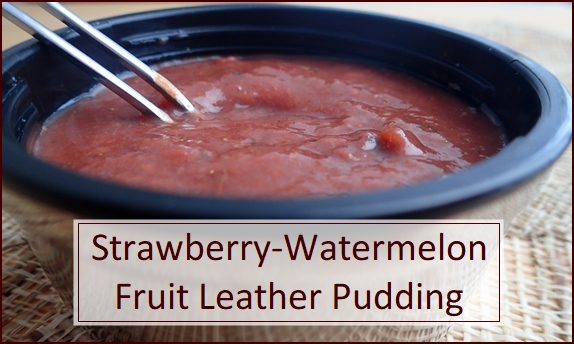
Photo: Strawberry-watermelon fruit leather rehydrated into pudding in the cap of a thermos food jar.
On the Trail: Stop in a shady spot for a midmorning break. Tear 1 sheet of fruit leather (35–40 grams) into pieces, and place in a container. Add ½-cup of cold filtered water and stir. Add a little more water once the leather is mostly dissolved. It takes only 10 minutes to enjoy this treat.
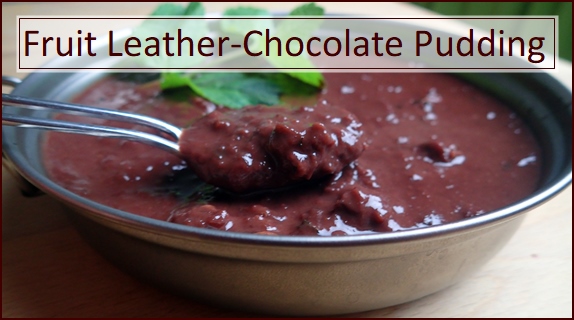
Photo: Cherry-watermelon fruit leather with chocolate and nuts.
Some like it hot…
On the Trail: After dinner, tear 1 sheet of fruit leather (35–40 grams) into pieces. Place in a pot with pieces of a chocolate candy bar (35–40 grams), and a small handful of chopped nuts (25 grams).
Add water. Start with ¾-cup of water and heat gently while stirring until the fruit leather dissolves and the chocolate melts. Add another ¼-cup of water if necessary. Continue heating until hot and delicious, about 10–15 minutes.
Dehydrating Watermelon Conclusion
Dehydrating watermelon in strips is the best way to enjoy 100% watermelon on the trail without much fuss. It tastes almost like candy with its concentration of natural sugars.
Blend “watery” watermelon with drier fruits to make watermelon fruit leather from a smooth mix. This method is easier than reducing the liquid by cooking the fruit first on the stove.
Dehydrated watermelon is stickier than other dehydrated fruits, so fold it up in parchment paper to keep it from sticking to itself.
Explore More…
Dehydrating Cantaloupe & Cantaloupe Fruit Leather
Dehydrating Fruit Table of Contents
Dehydrating Fruit Leather Table of Contents
Shop Amazon

Cosori Dehydrators and Silicone Trays & Mesh Sheets.
Cosori Dehydrator, Stainless Steel, 6-Trays
Silicone Dehydrator Trays with Raised Edges, 11.8" x 10.8", 6-Pack
Silicone Mesh Dehydrator Sheets, 14” x 14”, 12-Pack
Disclosure: As an Amazon Associate, Backpacking Chef earns from qualifying purchases. Thank you!
Share this page with friends on social media.
Free E-book & Newsletter
Free with Trail Bytes subscription.
Dehydrating Food from A–Z

